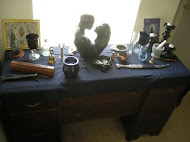
Picture from Raven Scout
Moonstone is a member of the feldspar group. It was named after its distinctive blue-white sheen. The moonstone is characterized by an enchanting play of light - indeed it owes its name to that mysterious shimmer which always looks different when the stone is moved and is known in the trade as 'adularescence'. The shimmer of light of the moonstone is something very special in the fascinating world of gemstones. The cause of it is the lamellar inner construction of the gemstone. Incident light rays are refracted and scattered in the stone. In this way, a unique light effect comes about, and it is this which makes the moonstone so distinctive and so desirable. A popular semi-precious stone, Moonstone comes in a variety of colors and shades, but is most often a whitish-blue. Other colors range anywhere from colorless to silvery-white, yellow to orange, green to gray, brown, peach, pink and a type that is multi-colored called Rainbow Moonstone.
In their uncut state moonstones are rather unprepossessing and afford little idea of what it is that actually constitutes their charm: that mysterious shimmer of light. For that shimmer is not really shown to advantage until the art of the cutter has been brought to bear. Classical moonstones are always cut as cabochons, the most important thing being the correct height of the stone. The cutter must also align the axes of the crystal precisely into the zenith of the stone, for that is the only way in which he will bring about the desired light effect.
Moonstones from Sri Lanka, the classical country of origin, shimmer in pale blue on an almost transparent background. Specimens from India feature a nebulous interplay of light and shadow on a background of beige-brown, green, orange or brown. They are also found in the USA, Brazil, Australia, Myanmar and Madagascar, as well as the European Alps near the Adula Group (hence the name 'adularia'). There have also been some with a smoky color, some the color of champagne, and some black and some reddish ones, mainly originating from India. Some have a cat's eye effect or a four-spoked star as well as the typical undulating shimmer of light. These stones are not only cut as cabochons, but also as artistic cameos or engraved with the faces of children, the moon or grotesques. But they too have the shimmer of light typical of the moonstone, as do the beads which are cut from suitable raw material for gemstone necklaces. Since bluish moonstones of good quality have been becoming more and more of a rarity in recent years, prices have risen sharply.
Moonstones should be handled with care, for they are sensitive. Having said that, minor flaws such as may occur when the stone has been worn for some time are quite easy to remedy. A jeweler can have a moonstone which has grown dull re-polished, after which it will shimmer again just as it did on the very first day.
In earlier times, people believed they could recognize in it the crescent and waning phases of the moon. This gemstone was very popular about a hundred years ago at the time of Art Nouveau. It adorns a noticeably large number of the jewelry creations of the French master goldsmith René Lalique and his contemporaries, mainly to be found in museums and collections today.
Moonstones are treasures of Nature with a sensual and seductive aura. Not only do they like to be looked at and admired a lot; they also thrive on being worn and moved about a good deal, for only then can the soft shimmer of light which makes this gemstone so desirable really come into its own.
Other names for Moonstone are Ceylonese Opal, Water Opal, Girasol, Fish-Eye and Wolf's-Eye. The highest and most sought after quality Moonstones come from Sri Lanka.
Metaphysical properties of moonstone:
This gemstone is surrounded by a good deal of mystique and magic. Moonstone's energies are soothing and nurturing. They can help calm and prevent over-reactions to personal situations that involve the emotions. It's energies are feminine in nature - they can help us all become more sensitive and loving. The subtle energies of moonstone can help to open and cleanse your heart. They are soothing and healing to the mind, emotions, and body. Although moonstone is seen as a feminine influence, it can also help balance the male and female aspects of yourself. This makes moonstone a good choice for men too, because many men could benefit from being more sensitive and better able to express love.
Moonstone is associated with all goddesses, but especially the Moon goddesses. Resembling the Moon or "moonshine", the ancient Romans believed the stone was actually formed from moonlight. In the Orient, people believed Moonstones were actual rays of moonlight that had solidified, and that the shimmering light held within the stone was a good spirit that lived there. In India, moonstone is considered sacred, and said to bring good fortune, but, more importantly, it is seen as a tool to promote spiritual enlightenment. That culture also regards it as 'dream stones' which bring the wearer beautiful visions at night. In Arabic countries, women often wear moonstones sewn out of sight into their garments, for in their culture the moonstone is a symbol of fertility. Amulets of Moonstone were frequently hung in fruit trees to ensure fruitful and abundant crops. In Asia and Europe the stone was associated with love and fidelity and was often worn when trying to attract a faithful lover. It was believed that if held in the mouth, Moonstone would help one make proper decisions. This versatile stone was also used in ancient times to cure insomnia. Moonstone has a powerful effect on women's menstrual cycles. Women are cautioned about wearing or carrying moonstone at times of the full moon or when they are menstruating.
Due to its association with water, Moonstone is said to be protective of those at sea. It is also protective of those that travel at night and especially during New Moon phases, and was once called the "Traveler's Stone". It was also thought to protect against insanity, epilepsy, and any adverse wanderings of the mind. The ancient Greeks called Moonstone "Aphroselene" after the goddesses Aphrodite (love) and Selene (moon). Moonstone can help you become more intuitive. It can also boost psychic ability. The moonstone symbolises our being in its entirety. With its soft shimmer, it strengthens our emotional and subconscious aspects, it is "lovers' stone", evoking tender feelings and safeguarding the true joys of love. It is also said that wearing a moonstone strengthens our intuition and our capacity to understand
Associations:
Astrological Sign(s): Cancer
Element(s): Water
Chakra(s): Third Eye (Brow)
Lunar (feminine) energy.
Intuition, Receptiveness, Reflective, Inner harmony, Balancing, Calming, Love and happiness, New beginnings, Lucid dreams, Enhances psychic ability, Protective (especially in travel) Gives physical aid in treating: Menstrual cycles, hormonal imbalances, and all female related health issues, Fertility, Circulatory system, Emotional distress, anxiety and stress, Assists with the cycles of change, Alleviates swellings and helps reduce excess fluids in the body, regenerative for eyes, skin and hair, Sleeping disorders.
*NOTE: Stone therapy should NOT take the place of medical evaluation and procedures, and should be used merely to enhance one's health and well-being.
Magical Uses:
Place a moonstone under your pillow in order to ensure a restful sleep.
Wear or carry a moonstone to bring a love into your life. On the night of a full moon and by its light, ring a pink candle with moonstones. Light the candle and visualize yourself in a loving relationship.
To see into the future, according to an ancient grimoire of the magical arts, place a moonstone amulet in your mouth at night when the moon is full.
Wear a ring of moonstone (dedicated to the love goddess Aphrodite) as amuletic jewelry to attract a soul mate, inspire tender passions, or to protect a love.
Carry a moonstone in a charm bag to attract good luck or prevent nervousness.
The powers of the moonstone (also known as the "stone of love") are extremely potent when it is worn or carried by persons born under the moon-ruled astrological sign of Cancer.
Pearl, Moonstone and Alexandrite are the birthstones of the month of June. To recharge Moonstone, place it under the light of the Full Moon.
Taken in part from:
Controverscial.com (sic)















No comments:
Post a Comment